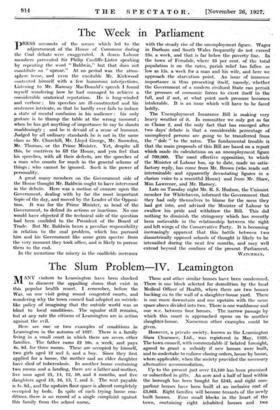The Slum Problem—IV. Leamington M ANY visitors to Leamington have been
shocked to discover the appalling slums that exist in this popular health resort. I remember, before the War, on one visit going round congested courts, and wondering why the town council had adopted. an ostrich- like policy of imagining that the outside world was so blind to local conditions. The squalor still remains, but at any rate the citizens of Leamington are in action against the evil..
Here are one or two examples of conditions in Leamington in the autumn of 1927. There is a family living in a small court in which there are seven. -other families. The father earns £2 10s. a week, and- pays 4s. 8d. for three rooms. These are occupied by himself, two girls aged 12 and 5, and a boy. Since they first applied for a house, the mother and an elder daughter have died of tuberculosis. In another house containing two rooms and a landing, there are a father and mother, five sons aged 21, 14, 12, 10, and 3 months, and five daughters aged 19, 16, 15, 7, and 5. The rent . payable is 4s. 8d., and the upstairs floor space is.alinost completely occupied by beds. In spite of such. trying home con- ditions, there is no record of a single complaint against this family from the school nurse.' These and other similar houses have been condemned. There is one block selected for demolition by the local Medical Officer of Health, where there are two houses backing on to the wall of a slaughter-house yard. There is one room downstairs and one upstairs with the same space above divided into two. There is one washhouse and one w.c. between four houses. The narrow passage by which this court is approached opens on to another slaughter-house. Numerous other. examples . could be given.
However, a private society, known as the Leamington Slum Clearance, Ltd:, was registered • in May, 1926. The town council, with commendable if belated foresight, agreed to grant' a subsidy if new houses were built, and to undertake to enforce closing orders, house by house, where applicable, when the society provided the necessary alternative accommodation.
Up to the present just over £4,100 has been promised or subscribed in gifts. An.acre and a half of land within the borough has been bought for £545, and eight non- parlour houses have been built at an inclusive cost of £3,863. Eight families will become tenants of the newly built houses. Four small blocks in . the heart of the town, containing eight inhabited houses and two officially closed houses, have been selected for demolition and will. be pulled down. The accommodation vacated . by those who lave moved into the new houses will be offered to the families who will be displaced from the condemned buildings. This is the system by which tenants arc moved upwards, a system of decanting that has been adopted by Glasgow and other progressive authorities.
Those responsible for the Leamington experiment intend to pay special attention to management, recog- nizing that where people are not taught how to use decent houses, these rapidly degenerate into slums. Indeed, some persons who have had a lifetime experience of insanitary property tell me that the problem of management is much more serious and difficult than the provision of new houses. It is said that at Leamington younger parents are specially anxious to find a good home. The first eight tenants under the new scheme are being selected from the most deserving, who can be relied on to be good tenants, and not to arouse difficulties in the neighbour- - hood to which they are being moved. - It is a tragedy that those who have lived for fifteen or twenty years in slum areas have almost lost hope and abandoned the struggle. But it is hoped later to discover some method by which to give help to those who in the past have shown- little initiative in helping themselves. The Leamington experiment offers several useful lessons of how to overcome peculiar local difficulties by tact and perseverance.
B. S. TOWNROE.























































 Previous page
Previous page